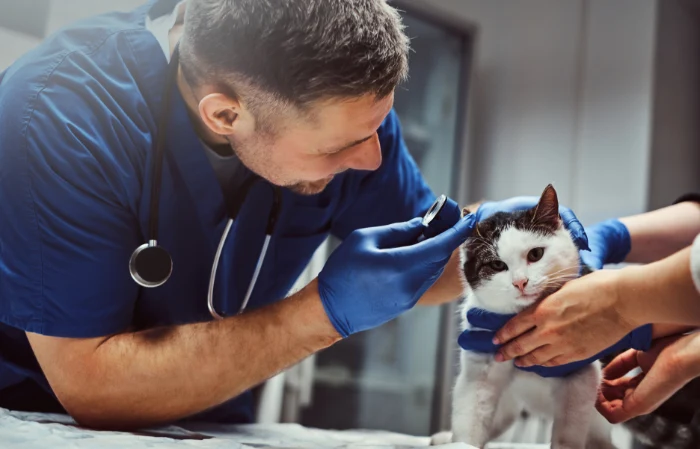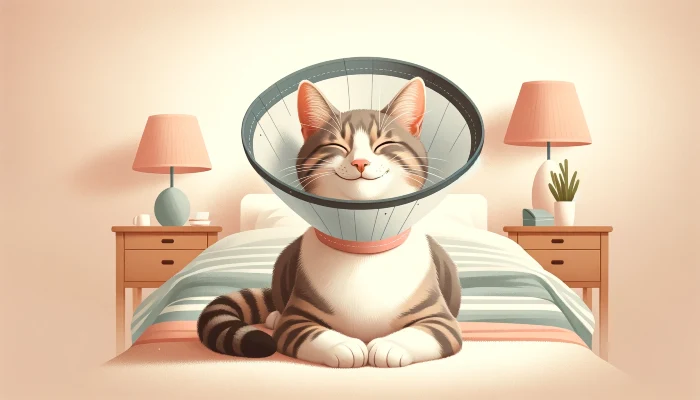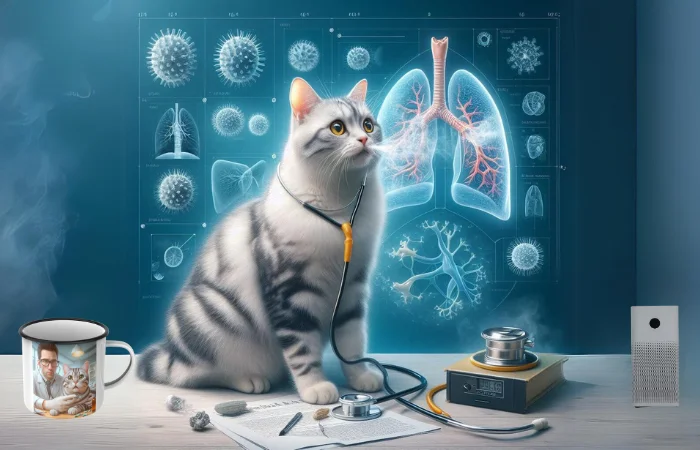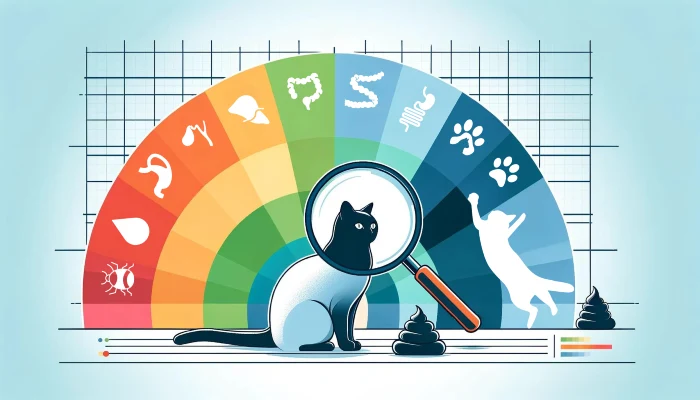Cats are known for their keen sense of hearing, making their ear health a crucial aspect of their overall well-being. Understanding the nuances of cat ear care is essential for any responsible cat owner.
This comprehensive guide will walk you through various facets of maintaining optimal ear health for your feline friend.
Survival Instincts and Ear Health: How Cats' Wild Nature Relates to Ear Problems
Imagine a wild cat, sleek and agile, prowling through dense undergrowth, its senses alert to every movement and sound. In the wilderness, where the rules of survival are written by instinct and adaptability, a cat’s ears are not just tools for hearing; they are vital assets that can make the difference between a successful hunt and an empty stomach.
In the wild, a cat’s ears are finely tuned instruments that serve a multitude of purposes beyond hearing prey and predators. The position of the ears, their movement, and their sensitivity to the faintest rustle or distant growl provide a cat with essential information about its environment. From pinpointing the location of potential prey to detecting the approach of a potential threat, a cat’s ears are its early warning system, enabling it to stay ahead in the perpetual game of survival.
Now, let’s consider how this instinctual behavior plays into ear problems in the wild.
Cats are masters of concealment, adept at masking any signs of vulnerability or discomfort. In the unforgiving world of nature, revealing pain or illness can be a fatal mistake. A cat that displays weakness becomes an easy target for predators or rivals, so they’ve developed an uncanny ability to hide their symptoms, even when faced with discomfort.
This survival strategy becomes particularly relevant when we talk about ear problems.

A wild cat with an ear infection or infestation, while undoubtedly feeling the pain and itchiness, might suppress the urge to scratch or shake its head excessively. It does so to avoid drawing attention to its weakened state, a behavior ingrained over generations of evolution. A behavior that is still present in today’s domestic house cats.
Even symptoms like excessive scratching or head tilting, which we as pet owners recognize as indicators of ear problems, can be subtle enough for a cat to downplay in its bid for survival.
Understanding this aspect of a cat’s nature is crucial for pet owners. Our domestic feline companions may not be facing the same life-and-death challenges as their wild counterparts, but they retain these instincts.
Cats often mask their discomfort, making it all the more important for us to stay vigilant and attuned to even the subtlest changes in their behavior.
When dealing with ear problems, we must consider this survival instinct. Our cats might not openly communicate their discomfort, but their well-being is in our hands.
Regular ear care, observation, and seeking veterinary attention at the first sign of trouble are our tools to ensure that our feline friends thrive just as they would in the wild, minus the harsh realities of survival. By tending to their ear health, we honor their ancestral instincts while providing the care and protection they need in the safety of our homes.
Breeds Prone to Ear Problems
Some cat breeds are more susceptible to ear problems due to their unique ear anatomy and genetic predispositions.
While any cat can experience ear issues, certain breeds are more prone to specific problems.
Breeds with large, erect ears or excessive hair in the ear canal are particularly susceptible. Some of the breeds known to be more prone to ear problems include:
- Scottish Fold: Due to their folded ears, moisture and debris can accumulate, leading to infections.
- Persian: Their long fur can trap dirt and wax, creating a breeding ground for problems.
- Sphynx: Without fur to protect the ears, Sphynx cats are more exposed to environmental factors.
- Siamese: Their large ears are more susceptible to irritation and infections.
- Maine Coon: The tufts of hair in their ears can contribute to earwax buildup.

Understanding why these breeds are more susceptible can help you take proactive steps to prevent ear problems.
Recognizing Symptoms of Infection
Maintaining vigilance in monitoring your cat’s ear health is essential for detecting infections early. Be on the lookout for the following symptoms:
- Excessive scratching or pawing at the ears.
- Shaking of the head or tilting it to one side.
- Foul odor emanating from the ears.
- Redness, inflammation, or swelling around the ears.
- Unusual discharge, which can range from dark and waxy to pus-like.
- Sensitivity or pain when the ears are touched.
If your cat displays any of these signs, it’s time to investigate further and seek veterinary attention promptly. Prompt action can prevent discomfort and more severe issues.
How to Clean Your Cat's Ears
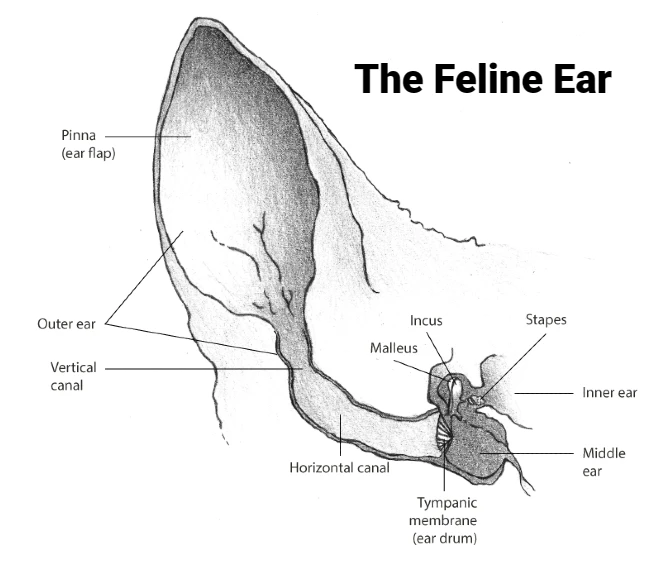
Cleaning your cat’s ears may sound daunting, but it’s a vital part of preventing ear problems. Here’s a step-by-step quick guide to safely and effectively clean your cat’s ears:
Gather Supplies: You’ll need cat-specific ear cleaning solution, cotton balls or gauze, and treats for rewards.
Prepare the Area: Choose a quiet, comfortable space for the cleaning process.
Hold Your Cat: Gently hold your cat or wrap them snugly in a towel and talk soothingly to keep them calm.
Inspect the Ears: Check for redness, inflammation, or discharge before proceeding.
Apply Ear Cleaner: Follow the instructions on the ear cleaning solution. Apply a few drops to the ear canal while gently massaging the base of the ear.
Let Your Cat Shake: Allow your cat to shake their head, which helps the solution reach deeper areas.
Wipe Excess: Gently wipe the visible area of the ear with a cotton ball or gauze.
Reward and Praise: Give your cat treats and praise for their cooperation.
Remember, regular cleaning is essential, but over cleaning can disrupt the natural balance in the ear. Consult your vet if you’re unsure about the frequency.
Products for Ear Cleaning and Health
Maintaining your cat’s ear health requires more than just occasional attention. Just like any other aspect of their well-being, their ears deserve consistent care and consideration.
Fortunately, a variety of products are available to aid in the endeavor of ensuring your feline friend’s ears are in top-notch condition.

Ear Wipes
These convenient wipes are designed to gently clean your cat's ears by removing debris, wax buildup, and dirt. Ear wipes are an excellent option for regular maintenance between deeper cleanings and vet visits. Remember, always be gentle when using ear wipes, and if you notice any signs of discomfort or irritation, discontinue use and consult your veterinarian.
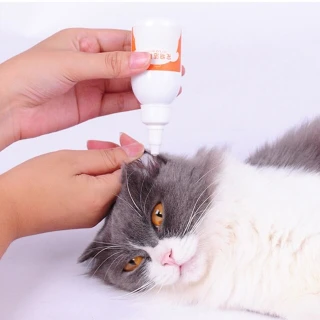
Ear Cleaning Solutions
Ear cleaning solutions are formulated to dissolve wax and debris while maintaining the delicate pH balance of your cat's ear canal. Your veterinarian can recommend a suitable cleaning solution that aligns with your cat's specific needs. Remember, never use cotton swabs or other foreign objects to clean your cat's ears, as this can push debris deeper or cause harm to the ear structures.
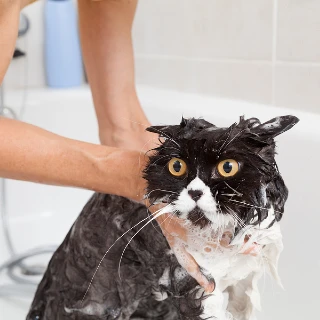
Specialized Drying Products
Moisture in the ears can create an environment conducive to bacterial or fungal growth. Specialized drying products are designed to help dry your cat's ears after bathing. They prevent the accumulation of moisture, which can contribute to ear infections. Ask your vet before adding anything to your cat's ear care routine.
When it comes to selecting the right products for your cat’s ear health, guidance from your veterinarian is invaluable. Their expertise enables them to tailor recommendations to your cat’s unique needs.
Keep in mind that your cat’s ear health can vary based on factors such as breed, age, and overall health.
A product that works well for one cat might not be suitable for another, so professional guidance ensures you make the best choices.
Your veterinarian can guide you in choosing products that are safe, effective, and in line with the specific requirements of your cat’s ears. They will take into account any existing conditions, allergies, or sensitivities to ensure that the chosen products support your cat’s well-being without causing any adverse reactions.
When to See Your Vet
While regular ear cleaning is beneficial, certain situations warrant a visit to the vet:
- Persistent Symptoms: If your cat’s symptoms persist or worsen after cleaning, it’s time to consult a professional.
- Intense Discomfort: Excessive scratching, head shaking, or crying indicates your cat is in distress.
- Foul Odor: A strong, unpleasant odor from the ears can indicate an infection.
- Bloody Discharge: Blood in the ears requires immediate veterinary attention.
Professional evaluation ensures proper diagnosis and treatment, preventing potential complications.
Common Ear Problems and Their Symptoms
Understanding and recognizing common ear problems in your cat is crucial for ensuring their comfort and well-being. Here are some prevalent ear issues and their associated symptoms that every cat owner should be aware of:
Otitis Externa (External Ear Inflammation)
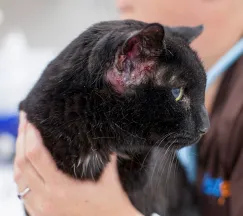
Otitis externa refers to inflammation of the external ear canal, and it’s a common problem in cats. This condition can be caused by various factors, including allergies, infections, and even foreign objects lodged in the ear.
The symptoms of otitis externa may include:
- Pain and Discomfort: Cats with this condition often display signs of discomfort, such as frequent scratching or rubbing of the affected ear.
- Redness and Swelling: Inflammation of the ear canal can lead to redness and swelling around the ear area.
- Discharge: You might notice abnormal discharge from the ear, which can range from a watery consistency to a thick and pus-like texture.
- Head Tilt: Cats experiencing ear inflammation may tilt their head to one side or shake their head more frequently.
If you observe any of these symptoms, it’s important to consult your veterinarian for proper diagnosis and treatment. Untreated otitis externa can lead to more severe complications and discomfort for your cat.
Ear Mites
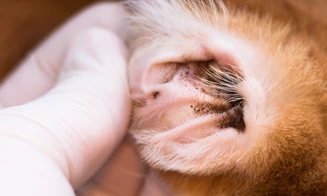
Ear mites are tiny parasites that can take residence in your cat’s ear canal. These minuscule pests can cause significant discomfort and itching for your feline friend. Symptoms of ear mite infestations include:
- Intense Itching: Cats with ear mites will often scratch at their ears vigorously, sometimes to the point of causing sores.
- Dark Discharge: You may notice a dark, coffee ground-like discharge in the ear canal. This discharge is a combination of blood, debris, and mites.
- Crusty Debris: Ear mites can cause the earwax to become dry and crumbly, leading to the presence of crusty debris in the ear.
Ear mites are highly contagious and can spread to other pets, so prompt treatment is essential. If you suspect your cat has ear mites, consult your vet for proper diagnosis and treatment options.
Yeast Infections
Yeast infections in the ears can occur when there’s an overgrowth of yeast organisms in the ear canal. While yeast is a normal inhabitant of the ears, an imbalance can lead to infection. Symptoms of a yeast infection in your cat’s ears include:
More To Discover
- Foul Odor: One of the telltale signs of a yeast infection is a strong, unpleasant odor emanating from the ears.
- Itching and Scratching: Cats with yeast infections often scratch their ears frequently due to the discomfort and itching.
- Brown or Yellow Discharge: You might notice a discolored discharge in the ears, which can range from brown to yellow in color.
- Head Shaking: Cats may shake their head or tilt it to one side in an attempt to alleviate the discomfort caused by the infection.
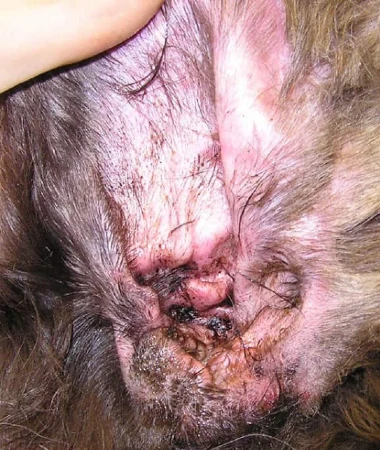
Yeast infections can be triggered by factors such as allergies, humidity, or moisture buildup in the ears. If you suspect your cat has a yeast infection, consult your veterinarian for appropriate treatment recommendations.
Your cat’s ears play a vital role in their overall sensory experience, and maintaining their ear health is paramount. Regular cleaning, attentive monitoring, and seeking professional guidance when needed are essential steps to ensure your cat’s ears remain healthy and problem-free.
By prioritizing ear care, you contribute to your cat’s overall well-being and quality of life.








